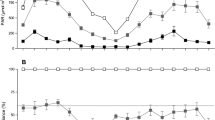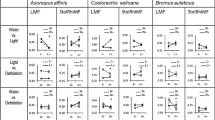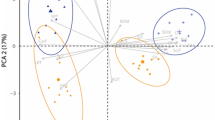Abstract
Nine temperate grass species were screened for their potential to grow in the low-light conditions typical of gaps in dense vegetation. To this end, photosynthetic photon flux densities (PFD) were simulated in a growth chamber (PFD 100, 50 or 25 μmol photons m−2 s−1). Relative and absolute growth rates (RGR and AGR, respectively) of the species were regressed on ten different ecophysiological and morphogenetic plant attributes. No significant relationships were found between plant attributes and relative growth rate, while six attributes explained a significant proportion of the interspecific variance in absolute biomass growth: net photosynthetic rate at growth PFD (P net ) (75.5%), leaf apparent quantum yield of CO2 fixation (62.5%), leaf dark respiration rate (65.2%), leaf compensation PFD (71.0%), root: shoot ratio (66.4%) and plant nitrogen content on a mass basis (42.0%). Only species with extremely low allocation to roots and very high (relatively speaking) net photosynthetic rates were able to grow fast in low light. Specific leaf area (SLA), instantaneous photosynthetic nitrogen use efficiency (PNUE) and leaf nitrogen content on a mass basis as well as on an area basis were not significantly related to growth. The absence of effects of plant traits on RGR, unlike for AGR, could arise from a relationship that we observed between AGR and a fitted start value of the biomass-time course (i.e. seed mass or germination time). This suggests that interspecific differences in the very early growth stages of the plants were responsible for differences in successful development under low light, rather than differences in RGR. Based on its high explanatory power, its relative constancy with plant age and the lack of effect of growth PFD, P net would be the best candidate for characterizing potentially shade-tolerant species that are likely to establish in dense vegetation in the field.




Similar content being viewed by others
References
Balandier P, Sinoquet H, Frak E, Giuliani R, Vandame M, Descamps S et al (2007) Six-year time course of light-use efficiency, carbon gain and growth of beech saplings (Fagus sylvatica) planted under a Scots pine (Pinus sylvestris) shelterwood. Tree Physiol 27:1073–1082
Björkman O (1981) Responses to different quantum flux densities. In: Large OL, Nobel PS, Osmond CB, Ziegler H (eds) Encyclopedia of plant physiology, vol. 12A (Plant Physiological Ecology). Springer, Berlin, pp 57–107
Bloor JMG (2003) Light responses of shade-tolerant tropical tree species in north-east Queensland: a comparison of forest- and shadehouse-grown seedlings. J Trop Ecol 19:163–170. doi:10.1017/S0266467403003183
Bloor JMG, Grubb PJ (2003) Growth and mortality in high and low light: trends among 15 shade-tolerant tropical forest tree species. J Ecol 91:77–85. doi:10.1046/j.1365-2745.2003.00743.x
Bradshaw L, Goldberg DE (1989) Resource levels in undisturbed vegetation and mole mounds in old fields. Am Midl Nat 121:176–183. doi:10.2307/2425668
Brokaw NVL (1985) Treefalls, regrowth, and community structure in tropical forests. In: Pickett STA, White PS (eds) The ecology of Natural Disturbance and Patch Dynamics. Academic press, London, pp 53–69
Bullock JM, Hill BC, Silvertown J, Sutton M (1995) Gap colonization as a source of grassland community change: effects of gap size and grazing on the rate and mode of colonization by different species. Oikos 72:273–282. doi:10.2307/3546229
Bullock JM (2000) Gaps and seedling colonization. In: Fenner M (ed) Seeds. The ecology of regeneration in plant communities. Cabi Publishing, New York, pp 375–395
Burke MJW, Grime JP (1996) An experimental study of plant community invasibility. Ecology 77:776–790. doi:10.2307/2265501
Claveau Y, Messier C, Comeau PG (2005) Interacting influence of light and size on aboveground biomass distribution in sub-boreal conifer saplings with contrasting shade tolerance. Tree Physiol 24:373–384
Collins BS, Dunne KP, Pickett STA (1985) Responses of forest herbs to canopy gaps. In: Pickett STA, White PS (eds) The ecology of natural disturbance and patch dynamics. Academic press, London, pp 218–234
Craine JM (2005) Reconciling plant strategy theories of Grime and Tilman. J Ecol 93:1041–1052. doi:10.1111/j.1365-2745.2005.01043.x
Craine JM, Reich PB (2005) Leaf-level light compensation points in shade-tolerant woody seedlings. New Phytol 166:710–713. doi:10.1111/j.1469-8137.2005.01420.x
Dalling JW, Hubbel SP (2002) Seed size, growth rate and gap microsite conditions as determinants of recruitment success for pioneer species. J Ecol 90:557–568. doi:10.1046/j.1365-2745.2002.00695.x
Dalling JW, Winter K, Hubbell SP (2004) Variation in growth responses of neotropical pioneers to simulated forest gaps. Funct Ecol 18:725–736. doi:10.1111/j.0269-8463.2004.00868.x
Delagrange S, Messier C, Lechowicz MJ, Dizengremel P (2004) Physiological, morphological and allocational plasticity in understory deciduous trees: importance of plant size and light availability. Tree Physiol 24:775–784
Denslow JS (1987) Tropical rainforest gaps and tree species diversity. Annu Rev Ecol Syst 18:431–451. doi:10.1146/annurev.es.18.110187.002243
Edwards GR, Crawley MJ (1999) Herbivores, seed banks and seedling recruitment in mesic grassland. J Ecol 87:423–435. doi:10.1046/j.1365-2745.1999.00363.x
Ehrenfeld JG, Zhu WX, Parsons WFJ (1995) Above- and belowground characteristics of persistent forest openings in the New Jersey Pinelands. Bull Torrey Bot Club 122:198–305. doi:10.2307/2996321
Evans JR, Poorter H (2001) Photosynthetic acclimation of plants to growth irradiance: the relative importance of specific leaf area and nitrogen partitioning in maximizing carbon gain. Plant Cell Environ 24:755–767. doi:10.1046/j.1365-3040.2001.00724.x
Felsenstein J (1985) Phylogenies and the comparative method. Am Nat 125:1–15. doi:10.1086/284325
Fichtner K, Koch GW, Mooney HA (1995) Photosynthesis, storage, and allocation. In: Schulze ED, Caldwell MM (eds) Ecophysiology of Photosynthesis. Springer, Berlin, pp 133–146
Givnish TJ (1988) Adaptation to sun and shade: a whole-plant perspective. Aust J Plant Physiol 15:63–92
Gloser J, Bartak M (1994) Net photosynthesis, growth rate and biomass allocation in a rhizomatous grass Calamagrostis epigejos grown at elevated CO2 concentration. Photosynthetica 30:143–150
Goldberg DE, Werner PA (1983) The effect of size of opening in vegetation and litter cover on seedling establishment of goldenrods (Solidago spp.). Oecologia 60:149–155. doi:10.1007/BF00379516
Harvey PH, Rambaut A (2000) Comparative analyses for adaptive radiations. Philos Trans R Soc Lond 355:1599–1605. doi:10.1098/rstb.2000.0715
Hunt R, Cornelissen JHC (1997) Components of relative growth rate and their interrelations in 59 temperate plant species. New Phytol 135:395–417. doi:10.1046/j.1469-8137.1997.00671.x
Huston M, Smith T (1987) Plant succession: life history and competition. Am Nat 130:168–198. doi:10.1086/284704
King SE, Grace JB (2000) The effects of gap size and disturbance type on invasion of wet pine savanna by cogongrass, Imperata cylindrica (Poaceae). Am J Bot 87(9):1279–1286. doi:10.2307/2656721
Kitajima K (1996) Cotyledon functional morphology, patterns of seed reserve utilization and regeneration niches of tropical tree seedlings. In: Swaine MD (ed) The ecology of tropical forest tree seedlings. Parthenon, Cranforth, pp 193–210
Larcher W (2003) Physiological plant ecology. Ecophysiology and stress physiology of functional groups. Springer, Berlin
Leishman M, Wright IJ, Moles AT, Westoby M (2000) The evolutionary ecology of seed size. In: Fenner M (ed) Seeds–the ecology of regeneration in plant communities. CAB International, Wallingford, pp 31–57
Levin SA, Mooney HA, Field C (1989) The dependence of plant root: shoot ratios on internal nitrogen concentration. Ann Bot (Lond) 64:71–75
Li B, Shibuya T, Yogo Y, Hara T, Matsuo K (2001) Effect of light quantity and quality on growth and reproduction of a clonal sedge, Cyperus esculentus. Plant Species Biol 16:69–81. doi:10.1046/j.1442-1984.2001.00049.x
Li ZQ, Bogaert J, Nijs I (2005) Gap pattern and colonization opportunities in plant communities: effects of species richness, mortality, and spatial aggregation. Ecography 28:777–790. doi:10.1111/j.2005.0906-7590.04261.x
Losos JB (1999) Uncertainty in the reconstruction of ancestral character states and limitations on the use of phylogenetic comparative methods. Anim Behav 58:1319–1324. doi:10.1006/anbe.1999.1261
McCarthy JJ, Canziani OF, Leary NA, Dokken DJ, White KS (eds) (2001) Climate Change 2001: Impacts, adaptation, and vulnerability. Contribution of working group II to the third assessment report of the intergovernemental panel on climate change. Cambridge University Press, Cambridge
Messier C, Doucet R, Ruel JC, Claveau Y, Kelly C, Lechowicz MJ (1999) Functional ecology of advance regeneration in relation to light in boreal forests. Can J For Res 29:812–823. doi:10.1139/cjfr-29-6-812
Méthy M, Alpert P, Roy J (1990) Effects of light quality and quantity on growth of the clonal plant Eichornia crassipes. Oecologia 84:265–271
Milbau A, Nijs I, Van Peer L, Reheul D, De Cauwer B (2003) Disentangling invasiveness and invasibility during invasion in synthesized grassland communities. New Phytol 159:657–667. doi:10.1046/j.1469-8137.2003.00833.x
Morgan JW (1997) The effect of grassland gap size on establishment, growth, and flowering of the endangered Rutidosis leptorhynchoides (Asateraceae). J Appl Ecol 34:566–576. doi:10.2307/2404907
Nijs I, Milbau A, Seidlova L (2004) New methodologies for analyzing and predicting alien plant invasions from species and ecosystem traits. Weed Technol 18:1240–1245
Pacala SW, Canham CD, Saponara J, Silander JA Jr, Kobe RK, Ribbens E (1996) Forest models defined by field measurements. II. Estimation, error analysis and dynamics. Ecol Monogr 66:1–43. doi:10.2307/2963479
Pakeman RJ, Attwood JP, Engelen J (1998) Sources of plants colonizing experimentally disturbed patches in an acidic grassland, in eastern England. J Ecol 56:1032–1041. doi:10.1046/j.1365-2745.1998.00327.x
Paz H, Mazer SJ, Martinez-Ramos M (2005) Comparative ecology of seed mass in Psychotria (Rubiaceae): within- and between-species effects of seed mass on early performance. Funct Ecol 19:707–718. doi:10.1111/j.1365-2435.2005.00984.x
Poorter H, Remkes C, Lambers H (1990) Carbon and nitrogen economy of 24 wild species differing in relative growth rate. Plant Physiol 94:621–627
Poorter L (1999) Growth responses of 15 rain-forest tree species to a light gradient: the relative importance of morphological and physiological traits. Funct Ecol 13(3):396–410. doi:10.1046/j.1365-2435.1999.00332.x
Price T (1997) Correlated evolution and independent contrasts. Philos Trans R Soc Lond 352:519–529. doi:10.1098/rstb.1997.0036
Rees M (1995) EC-PC comparative analyses? J Ecol 83:891–893. doi:10.2307/2261426
Reich PB, Walters MB, Ellsworth DS, Vose JM, Volin JC, Gresham C et al (1998) Relationships of leaf dark respiration to leaf nitrogen, specific leaf area and leaf life-span: a test across biomes and functional groups. Oecologia 114:471–482. doi:10.1007/s004420050471
Ricklefs RE, Starck JM (1996) Applications of phylogenetically independent contrasts: a mixed progress report. Oikos 77(1):167–172. doi:10.2307/3545598
Schär C, Vidale PL, Lüthi D, Frei C, Häberli C, Liniger MA et al (2004) The role of increasing temperature variability in European summer heatwaves. Nature 427:332–336. doi:10.1038/nature02300
Schmidt J, Wulff RD (1993) Light spectral quality, phytochrome, and plant competition. Trends Ecol Evol 8:47–50. doi:10.1016/0169-5347(93)90157-K
Seneviratne SI, Lüthi D, Litschi M, Schär C (2006) Land-atmosphere coupling and climate change in Europe. Nature 443:205–209. doi:10.1038/nature05095
Seoane J, Carrascal LM, Alonso CL, Palomino D (2005) Species specific traits associated to prediction errors in bird habitat suitability modelling. Ecol Modell 185:299–308. doi:10.1016/j.ecolmodel.2004.12.012
Shipley B (2002) Trade-offs between net assimilation rate and specific leaf area in determining relative growth rate: relationship with daily irradiance. Funct Ecol 16:682–689. doi:10.1046/j.1365-2435.2002.00672.x
Silvertown J, Smith BA (1988) Gaps in the canopy: the missing dimension in vegetation dynamics. Vegetatio 77:56–60. doi:10.1007/BF00045750
Sims DA, Pearcy RW (1993) Sunfleck frequency and duration affects growth rate of the understory plant, Alocasia macrorrhiza. Funct Ecol 7:683–689. doi:10.2307/2390189
Stuefer JF, Huber H (1998) Differential effects of light quantity and spectral light quality on growth, morphology, and development of two stoloniferous Potentilla species. Oecologia 117:1–8. doi:10.1007/s004420050624
Tilman D (1998) Plant strategies and the dynamics and structure of plant communities. Princeton University Press, Princeton
Vandvik V (2004) Gap dynamics in perennial subalpine grasslands: trends and processes change during secondary succession. J Ecol 92:86–96. doi:10.1111/j.1365-2745.2004.00842.x
Van Peer L, Nijs I, Bogaert J, Verelst I, Reheul DI (2001) Survival, gap formation, and recovery dynamics in grassland ecosystems exposed to heat extremes: the role of species richness. Ecosystems (N Y, Print) 4:797–806. doi:10.1007/s10021-001-0047-7
Veneklaas EJ, Poorter L (1998) Growth and carbon partitioning of tropical tree seedlings in contrasting light environments. In: Lambers H, Poorter H, Van Vuuren MMI (eds) Inherent variation in plant growth: physiological mechanisms and ecological consequences. Backhuys Publishers, Leiden, pp 337–362
Walters MB, Reich PB (1999) Low-light carbon balance and shade tolerance in the seedlings of woody plants: do winter deciduous and broad-leaved evergreen species differ? New Phytol 143:143–154. doi:10.1046/j.1469-8137.1999.00425.x
Walters MB, Reich PB (2000) Seed size, nitrogen supply, and growth rate affect tree seedling survival in deep shade. Ecology 81(7):1887–1901
Watkinson AR, Ormerod SJ (2001) Grassland, grazing and biodiversity: editors’ introduction. J Appl Ecol 38:233–237. doi:10.1046/j.1365-2664.2001.00621.x
Watson RT, Zinyowera MC, Moss RH, Dokken DJ (1998) The regional impacts of climate change: an assessment of vulnerability. Cambridge, Cambridge University Press
Wayne PM, Bazzaz FA (1993) Birch seedling responses to daily time courses of light in experimental forest gaps and shadehouses. Ecology 74(5):1500–1515. doi:10.2307/1940078
Westoby M, Leishman MR, Lord JM (1995a) On misinterpreting the ‘phylogenetic correction’. J Ecol 83:531–534. doi:10.2307/2261605
Westoby M, Leishman MR, Lord JM (1995b) Further remarks on phylogenetic correction. J Ecol 83:727–734. doi:10.2307/2261640
Westoby M, Leishman MR, Lord JM (1995c) Issues of interpretation after relating comparative datasets to phylogeny. J Ecol 83:892–893
Acknowledgements
This research was supported by the Federal Office for Scientific, Technical and Cultural Affairs (Prime Minister’s Office, Brussels, Belgium) under the Programme SPSD II. A. Milbau currently holds a grant from FWO-Vlaanderen as a post-doctoral researcher.
Author information
Authors and Affiliations
Corresponding author
Rights and permissions
About this article
Cite this article
Seidlova, L., Verlinden, M., Gloser, J. et al. Which plant traits promote growth in the low-light regimes of vegetation gaps?. Plant Ecol 200, 303–318 (2009). https://doi.org/10.1007/s11258-008-9454-6
Received:
Accepted:
Published:
Issue Date:
DOI: https://doi.org/10.1007/s11258-008-9454-6




